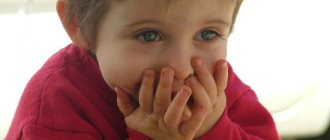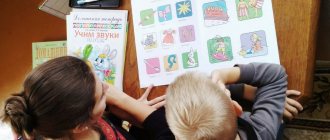The state of general speech underdevelopment (GSD) is characterized by a violation of all aspects of the formation of speech skills.
Its main distinguishing feature is the presence of problems both with the sound side (pronunciation), and with lexical and grammatical aspects. At the same time, children with general speech underdevelopment do not have hearing or intellectual impairments. Distinctive features of OHP:
- The presence of problems both with the pronunciation of sounds and with the skills of coherent expressive speech, mastering the rules of grammatical structure and a poor active vocabulary.
- Hearing is not impaired. A specialist check is required.
- Primary intelligence is normal. That is, a child at birth does not have a diagnosis of “mental retardation,” etc. However, it is worth keeping in mind that long-term uncorrected mental retardation can also lead to mental retardation.
It is possible to talk about the presence of general speech underdevelopment in a child only after 3-4 years. Until this time, children develop differently and “have the right” to some deviations from average norms. Everyone has their own pace of speech formation. But after 3, it’s worth paying attention to how the child speaks. It is quite possible that he needs the help of a speech therapist.
The manifestation of OHP in children is expressed differently based on their depth of impairment.
General speech underdevelopment level 1
A violation of this degree means an almost complete absence of speech in the child. Problems are visible to what is called the “naked eye.”
What does it show:
- A child's active vocabulary is very poor. To communicate, he uses mainly babbling words, the first syllables of words, and onomatopoeia. At the same time, he is not at all averse to communicating, but in “his” language. A cat means “meow”, “beep” can mean a car, a train, or the process of driving itself.
- Gestures and facial expressions are widely used. They are always appropriate, carry a specific meaning and, in general, help the child communicate.
- Simple sentences either simply do not exist in the child’s speech, or may consist of two amorphous words combined in meaning. “Meow bee bee” during the game will mean that the cat drove the car. “Woof di” means both the dog is walking and the dog is running.
- At the same time, the passive vocabulary significantly exceeds the active one. The child understands spoken speech to a much greater extent than he can say himself.
- Compound words (consisting of several syllables) are abbreviated. For example, bus sounds like "abas" or "atobu". This indicates that phonemic hearing is unformed, that is, the child does not distinguish individual sounds well.
Causes
There are several groups of reasons under the influence of which these disorders can occur:
- Pathologies in intrauterine development - toxicosis in the mother in the early stages (when the baby’s nervous system is being formed and formed), various diseases suffered by the mother during the first trimester of pregnancy (viruses and infectious diseases are especially dangerous in the first trimester of pregnancy), Rh conflict.
- Birth pathology - traumatic brain injury, suffocation by the umbilical cord (asphyxia), as a result of which the newborn experiences oxygen starvation, and this, in turn, negatively affects not only the speech centers of the cerebral cortex, but also all other organs and systems.
- Diseases suffered by the child in the first year of life - viral, infectious, various injuries.
- Hereditary factor.
- Negative influence of the environment - the absence or insufficiency of a correctly speaking environment for the child - speech disorders in parents, father and mother with hearing loss (in hearing children), various traumatic situations, frequent and long-term hospitalizations of children.
General speech underdevelopment level 2
The main striking difference from level 1 is the constant presence in the child’s speech of a certain number of commonly used words, although not yet pronounced very correctly. At the same time, the beginnings of the formation of a grammatical connection between words are noticeable, although not yet permanent.
What to pay attention to:
- The child always uses the same word, denoting a specific object or action in a distorted form. For example, apple will always sound like “lyabako” in any context.
- The active dictionary is quite poor. The child does not know words denoting the characteristics of an object (shape, its individual parts).
- There is no skill in combining objects into groups (a spoon, plate, pan are utensils). Objects that are similar in some way can be called in one word.
- Sound pronunciation is also far behind. The child pronounces many sounds poorly.
- A characteristic feature of level 2 OHP is the appearance in speech of the rudiments of a grammatical change in spoken words depending on the number. However, the child can only cope with simple words even if the ending is stressed (go - goUt). Moreover, this process is unstable and does not always manifest itself.
- Simple sentences are actively used in speech, but the words in them are not consistent with each other. For example, “papa pitya” - dad came, “guyai gokam” - walked on the hill, etc.
- Prepositions in speech may be completely missed or used incorrectly.
- A coherent story - based on a picture or with the help of an adult's questions - is already obtained, in contrast to the state at level 1 OHP, but it is very limited. Basically, the child uses two-syllable, inconsistent sentences consisting of a subject and a predicate. “Guyai gokam. Videy seg. Ipiy segika." (Walked on a hill, saw snow, made a snowman).
- The syllabic structure of polysyllabic words is disrupted. As a rule, syllables are not only distorted due to incorrect pronunciation, but also rearranged and simply thrown out. (Boots are “bokiti”, people are “tevek”).
Diagnostics
Recognizing and identifying various speech disorders is not only the function of a speech therapist. Primary diagnosis is carried out by the parents or the child’s immediate circle. In the era of the development of modern technologies, every interested adult is able to independently monitor the speech development of their baby, as well as contribute to the activation of these processes. Adults can also notice the first signs of delayed speech development.
Speech development and general physical condition are also monitored by pediatric specialists (including a neurologist and pediatrician). Their conclusions help the speech therapist to create a complete picture - to study the so-called “speech anamnesis” - features of the course of pregnancy, childbirth, and the first year of the child’s life.
General speech underdevelopment level 3
This stage is characterized mainly by a lag in terms of grammatical and phonemic development of speech. Expressive speech is quite active, the child constructs detailed phrases and uses a large vocabulary.
Problem points:
- Communication with others is mainly in the presence of parents, who act as assistant translators.
- Unstable pronunciation of sounds that the child has learned to pronounce separately. In independent speech they still sound unclear.
- Sounds that are difficult to pronounce are replaced by others. Whistling, hissing, sonorant and affricates are more difficult to master. One sound can replace several at once. For example, the soft “s” often plays different roles (“syanki” - sledge, “syuba” - “fur coat”, “syapina” - “scratch”).
- The active vocabulary is noticeably expanding. However, the child does not yet know the little-used vocabulary. It is noticeable that in his speech he uses mainly words of everyday meaning, which he often hears around.
- The grammatical connection of words in sentences, as they say, leaves much to be desired, but at the same time the child confidently approaches the construction of complex and complex constructions. (“Papa wrote and pyinesya Mise padaik, how Misya haase behave yourself” - Dad came and brought Misha a gift, BECAUSE Misha behaved well. As we see, a complex construction is already “asking for the tongue”, but the grammatical agreement of words is not yet given ).
- From such incorrectly formed sentences, the child can already compose a story. Sentences will still only describe a specific sequence of actions, but there will no longer be a problem with constructing phrases.
- A characteristic feature is the inconsistency of grammatical errors. That is, in one case, a child can correctly coordinate words with each other, but in another, use the wrong form.
- There are difficulties in correctly agreeing nouns with numerals. For example, “three catsAM” - three cats, “many sparrows” - many sparrows.
- The lag in the formation of phonemic abilities is manifested in errors when pronouncing “difficult” words (“gynasts” - gymnasts), in the presence of problems in analysis and synthesis (the child finds it difficult to find words starting with a specific letter). This, among other things, delays the child’s readiness to succeed in school.
Experts to contact
Often, speech disorders are accompanied by neurological pathology, which is expressed by a slow rate of maturation of the nervous system. Therefore, a competent specialist will prescribe special medications that will promote and stimulate its ripening. Accordingly, a neurologist will treat the little patient.
Some children experience psychological difficulties when their words, phrases and sentences are incomprehensible to peers and family. Therefore, in order to cope with them and not lead the child to logophobia (fear of speaking), a child psychologist gets involved. In addition, preschoolers with ODD suffer from higher mental functions that are closely related to speech: memory, attention, thinking.
Speech therapist. The main role in overcoming the above disorders is assigned to this specialist, who will conduct a competent diagnosis, determine the degree of speech development, and outline a lesson plan, goals and objectives. With level 1 OSD, an individual approach to each individual child is necessary, since speech disorders are diverse. The ideal solution would be for the child to attend a speech therapy kindergarten.
Prevention
Preventive measures flow smoothly from the causes of violations:
- For a woman planning to become a mother, it is important to prepare herself and her body for bearing a baby, take good care of herself, see a doctor, and follow all his recommendations.
- Unfortunately, the moment of childbirth does not always depend on the expectant mother - the main role here is played by medical personnel, or rather by the professionalism and responsibility of each individual employee. The woman, in turn, can have a positive attitude towards the process of childbirth.
- The first year of a baby's life is the most important. The sooner a violation can be detected, the sooner treatment and corrective work can begin.
Classification
According to the clinical picture of manifestations of ONR, it is divided into three groups:
- Uncomplicated form. Such children have minimal brain dysfunction, insufficient regulation of muscle tone, and immature volitional and emotional spheres.
- Complicated form. Occurs in patients with a number of neurological or psychopathic diseases, convulsive, cerebrasthenic and others.
- Gross underdevelopment. Children have lesions in the speech areas of the brain, that is, in the presence of alalia and dysarthria.
OHP also has its own degrees of severity. There are four in total:
- first degree - speechless, with the absence of commonly used speech;
- second degree – there are basic elements of common speech, poor vocabulary, agrammatism;
- third – the presence of phrasal speech, with underdevelopment of sound and semantic components;
- fourth degree – some problems in the phonetic-phonemic and lexical-grammatical aspects of speech.
Depending on the degree of complexity, the duration of correctional work of OHP by a speech therapist is determined.
Principles of therapy
Correction and treatment of this pathology is carried out by several specialists who use various methods and techniques:
- A speech therapist should begin his work by developing an understanding of the speech of others.
- Gradually accumulate means of communication (increasing vocabulary, expanding the meanings of words, forming correct sound pronunciation).
- Mastering various forms of communication.
Corrective speech therapy work should be combined with concomitant treatment - taking medications, physiotherapy, which will promote and stimulate the maturation of the central nervous system.
Particular attention should be paid to fine motor skills, since training the muscle tone of the fingers helps to activate the brain centers responsible for speech. Finger exercises, games with ice, dough, sandpaper, contrasting hand baths, Kuznetsov’s applicator, etc. have proven their effectiveness.
A favorable prognosis is when the pathology is detected on time and timely treatment and logocorrection are started. If parents are not interested, then the consequences will be sad.
Recommendations
One of the most important and important recommendations is the joint work of the child, parents and specialists (doctors, speech therapist, psychologist, teacher).
After all, if a preschooler visits a speech therapist, works with him, and at home does not make any efforts to consolidate the skills he has developed, there will not be a proper and necessary effect or he will have to wait a significant amount of time for it. Many parents believe that if a speech therapist or psychologist works with a child, then this is quite enough and they do not need to do anything. This is not so, all new skills and achievements of children must be repeated and improved in familiar situations, they must develop the habit of pronouncing sounds or words correctly.
Correction of the disorder
Corrective work on OHP should only be carried out by a qualified specialist. Preschool children with the first degree of speech impairment attend special speech therapy groups in kindergarten. They must enter here at the age of 3-4 years, and the classes themselves are conducted in groups, subgroups and individually. The purpose of correction is to transfer the child to another stage of speech development, to compensate for all existing deviations.
This work is carried out simultaneously in various directions:
- Speech understanding. This problem can be better solved by conducting classes in a playful way. The child must find toys that the specialist names for him, show the correct pictures, expand his vocabulary, and master the pronunciation of phrases, phrases, and multi-word phrases.
- Speech activation. Development of onomatopoeia in a child, for example, the voices of various animals, musical instruments. This stimulates his speech activity. Pronouns, verbs, and addressing an adult are gradually introduced into speech.
- Non-speech development. Correct speech is impossible without the development of auxiliary mechanisms - concentration, development of thinking, memory. Much attention should be paid to the intellectual and mental development of the child. Auxiliary techniques include logorhythmics, speech therapy massage, development of fine motor skills and articulation.
At the last stage, sound pronunciation must be performed with correct grammar and speech format. Treatment of second-degree ODD includes the development of the child’s speech skills, his understanding of adult speech, and training of the lexical and grammatical component. At the third degree, coherent semantic speech is formed, vocabulary and grammar are improved, and correct articulation is consolidated. A lot of time should be devoted to mastering the necessary literacy.
For children with SEN IV, it is important to achieve their age-specific speech standards, which is necessary for successful studies at school. Schoolchildren with severe forms of ODD are trained in schools created to work with children with speech disorders. Here the emphasis is on compensation for all aspects of the manifestation of speech underdevelopment1.







